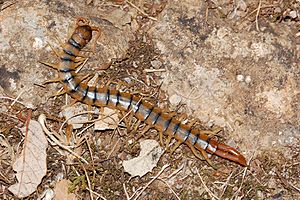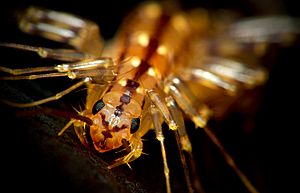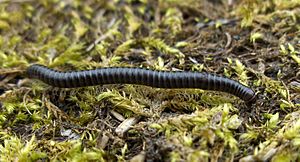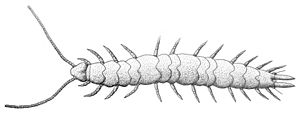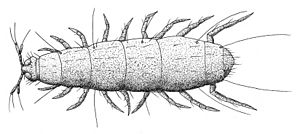Myriapoda facts for kids
The Myriapoda is a subphylum of arthropods. It contains the millipedes, centipedes, and others. The group has 13,000 species, all of which are terrestrial. Their name suggests they have many legs. In fact one has over 750 legs (Illacme plenipes), but some have fewer than ten legs.
The fossil record of myriapods goes back into the late Silurian, though molecular evidence suggests they diversified in the Cambrian period. Cambrian fossils do exist which look like myriapods.
Contents
Structure
Myriapods have a single pair of antennae and, in most cases, simple eyes. The mouthparts lie on the underside of the head. There is an "epistome" and labrum forming the upper lip, and a pair of maxillae forming the lower lip. A pair of mandibles lie inside the mouth. Myriapods breathe through spiracles that connect to a tracheal system similar to that of insects.
Classification
There has been much debate as to which arthropod group is most closely related to the Myriapoda. Under the Mandibulata hypothesis, Myriapoda is the sister taxon to Pancrustacea, a group comprising the Crustacea and Hexapoda. Under the Atelocerata hypothesis, Hexapoda is the closest, whereas under the Paradoxopoda hypothesis, Chelicerata is the closest. This last hypothesis, although supported by few morphological characters, is supported by a number of molecular studies.
There are four classes of living myriapods, Chilopoda (centipedes), Diplopoda (millipedes), Pauropoda and Symphyla. There is a total of around 12,000 living species. While each of these groups of myriapods is believed to be monophyletic, relationships among them are less certain.
Centipedes
Centipedes make up the order Chilopoda. They are fast, predatory and venomous, hunting mostly at night. There are around 3,300 species, ranging from the diminutive Nannarup hoffmani (less than half an inch in length, c. 12 mm) to the giant Scolopendra gigantea, which may exceed 30 centimetres (12 in).
Millipedes
Millipedes are the class Diplopoda, where most segments appear to have two pairs of legs. This happened because each pair of body segments fused (joined) into a single unit, which gives them the appearance of having two pairs of legs per segment.
They are slower than centipedes, and feed on leaf litter and detritus. Around 8,000 species have been described, which may represent less than a tenth of the true global millipede diversity. One species, Illacme plenipes has the greatest number of legs of any animal, with 750. Millipedes typically have between 36 and 400 legs. Pill millipedes are much shorter, and are capable of rolling up into a ball, like pillbugs.
Symphyla
About 200 species of symphylans are known worldwide. They resemble centipedes but are smaller and translucent. Many spend their lives as soil infauna, but some live arboreally. Juveniles have six pairs of legs, but, over a lifetime of several years, add an additional pair at each moult so that the adult instar has twelve pairs of legs.
Pauropoda
Pauropoda is another small group of small myriapods. They are typically 0.5–2.0 mm long and live in the soil on all continents except Antarctica. Over 700 species have been described. They are believed to be the sister group to millipedes, and have the dorsal tergites fused across pairs of segments, similar to the more complete fusion of segments seen in millipedes.
Arthropleuridea
Arthropleuridea were ancient myriapods that are now extinct. The most famous members are from the genus Arthropleura, which was a giant, probably herbivorous, animal that could be up to 3 metres (9.8 ft) long. Arthropleuridea may be a division of the millipedes.
Images for kids
-
Some of the various hypotheses of myriapod phylogeny. Morphological studies (trees a and b) support a sister grouping of Diplopoda and Pauropoda, while studies of DNA or amino acid similarities suggest a variety of different relationships, including the relationship of Pauropoda and Symphyla in tree c.
See also
 In Spanish: Myriapoda para niños
In Spanish: Myriapoda para niños


